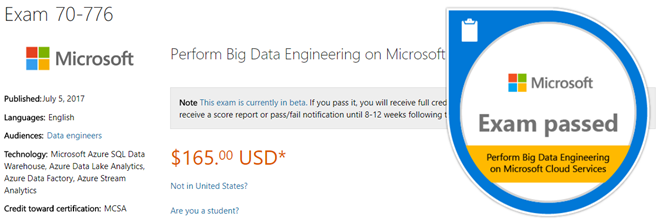There is a new exam currently in beta titled “Perform Big Data Engineering on Microsoft Cloud Services (beta)”. With all new exams there is little content on how to revise for the exam beyond the exams summary. This exam however, is what Adatis specialises in! Microsoft may call this “Big Data Engineering” we call it “Modern Data Analytics” and we have a few blogs on the subject. You can sign up to the exam here.
Below you will find links to blog posts by Adatis consultants on topics related to all the key objectives of this exam. I will endeavour to keep this up-to-date with new content added by the team. Good luck with the exam.
Design and Implement Complex Event Processing By Using Azure Stream Analytics (15-20%)
Streaming data is vital to achieving real-time analytics. The following blogs posts focus on this and offer an introduction and walkthrough for getting started with Stream Analytics. When talking about a wider Lambda approach to Big Data, streaming enables rapid processing via a “Speed” layer.
Adatis Hackathon Jan 2015 – Streaming Analytics First Thoughts
IoT Hub, Device Explorer, Stream Analytics, Visual Studio 2015 and Power BI
Power BI Streaming Datasets – An Alternative PowerShell Push Script
Data Data Revolution
Design and Implement Analytics by Using Azure Data Lake (25-30%)
Azure Data Lake Store and Analytics are a vital component of the “Modern Data Analytics”. Data which is too large for traditional single server processing needs distributed parallel computation. Rather than pulling data and processing ADLA pushes the processing to the data. Understanding how to process large volumes of data is one part of the “Batch” layer in Lambda
Data Lakes
Data Flow Job Execution in the Azure Data Lake
Data Flow Pt2: Vertexes in Azure Data Lake
Design and Implement Azure SQL Data Warehouse Solutions (15-20%)
Either as an alternative or in accompaniment to Data Lake is Azure SQL Data Warehouse. If Data Lake is batch across many files, Azure SQLDW is parallel batch over many databases. The key to both services is processing at the storage and not at the compute. The following is an on-going blog series covering the basics all the way to a deep-dive.
A Guide to Azure SQL DataWarehouse
Azure SQLDW – What is it?
Azure SQLDW – How Does Scaling Work?
Azure SQLDW – Distribution
Azure SQLDW – Polybase
Azure SQLDW – Polybase Designs
Azure SQLDW – Polybase Limitations
Azure SQLDW – CTAS Statements
Design and Implement Cloud-Based Integration by using Azure Data Factory (15-20%)
If you’re looking for a paas solution to move data in Azure, there is only really one option. Azure Data Factory. The following blogs will get you up-to-speed with ADF.
Getting Started with Azure Data Factory
Setting Up Your First Azure Data Factory
Azure Data Factory – Using the Copy Data Task to migrate data from on premise SQL Server to Blob Storage
Manage and Maintain Azure SQL Data Warehouse, Azure Data Lake, Azure Data Factory, and Azure Stream Analytics (20-25%)
Know each of the parts is only half the battle, you need to know how, when and why to use each part. What are the best practices?
Deploying a Hybrid Cloud
Azure Data Factory – Suggested naming conventions and best practices
Azure Data Lake Store Storage and Best Practices
Shaping The Lake: Data Lake Framework


Introduction to Data Wrangler in Microsoft Fabric
What is Data Wrangler? A key selling point of Microsoft Fabric is the Data Science
Jul
Autogen Power BI Model in Tabular Editor
In the realm of business intelligence, Power BI has emerged as a powerful tool for
Jul
Microsoft Healthcare Accelerator for Fabric
Microsoft released the Healthcare Data Solutions in Microsoft Fabric in Q1 2024. It was introduced
Jul
Unlock the Power of Colour: Make Your Power BI Reports Pop
Colour is a powerful visual tool that can enhance the appeal and readability of your
Jul
Python vs. PySpark: Navigating Data Analytics in Databricks – Part 2
Part 2: Exploring Advanced Functionalities in Databricks Welcome back to our Databricks journey! In this
May
GPT-4 with Vision vs Custom Vision in Anomaly Detection
Businesses today are generating data at an unprecedented rate. Automated processing of data is essential
May
Exploring DALL·E Capabilities
What is DALL·E? DALL·E is text-to-image generation system developed by OpenAI using deep learning methodologies.
May
Using Copilot Studio to Develop a HR Policy Bot
The next addition to Microsoft’s generative AI and large language model tools is Microsoft Copilot
Apr